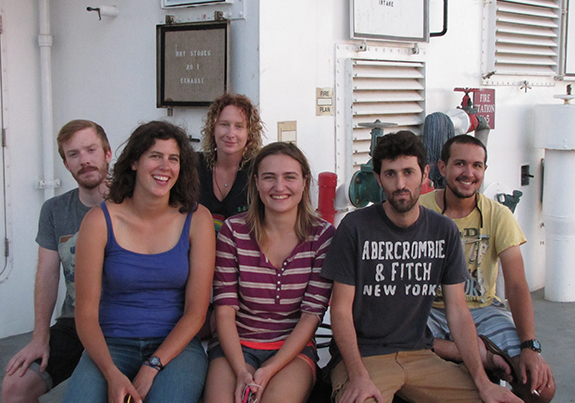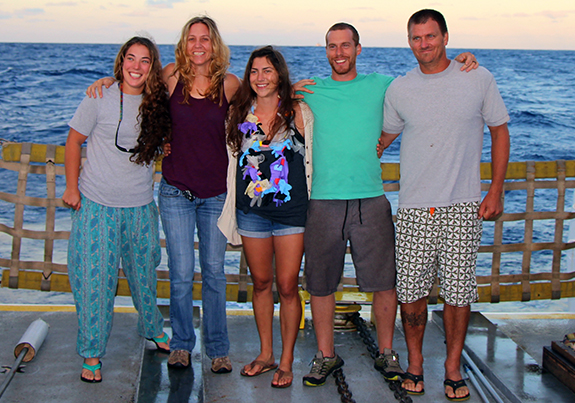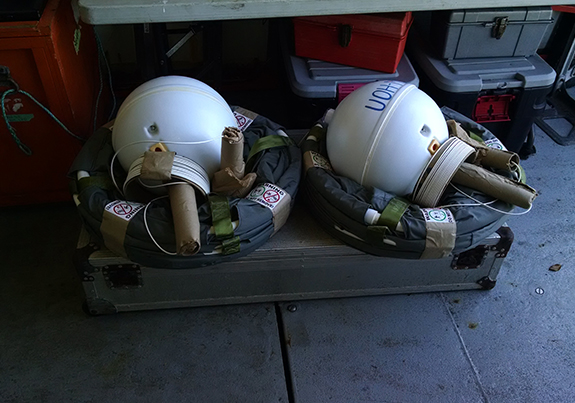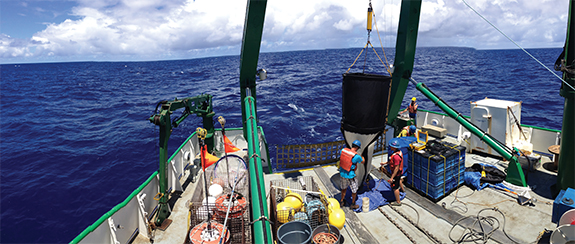
"A focus for this cruise was to peer more deeply than ever into the 'days in the life' of oceanic microbial communities."
-Edward DeLong
After much debate over the costs and benefits of spatial versus temporal studies, Simons Collaboration on Ocean Processes and Ecology (SCOPE) researchers
decided to investigate temporal variability in ecosystems during their 2015 summer cruise to the Pacific waters north of
Oahu, Hawai'i.
SCOPE's 16 investigators, assisted by 26 postdoctoral researchers and 11 graduate students, aim to advance our understanding of the biology, ecology and biogeochemistry of microbial processes that dominate Earth's largest biome: the global ocean.
"The 2015 cruise was a tremendous success. We couldn't have planned it any better than we did," said SCOPE co-director Dave Karl at the collaboration's annual meeting at the Simons Foundation's headquarters in December.
Since September 2014, SCOPE scientists have participated in 17 Hawai'i Ocean Time Series (HOT) cruises, allowing them to extensively sample the water column of the North Pacific Subtropical Gyre between 5 and 175 meters and, on 10 of those profiles, to survey microbes from the surface to depths of 4,000 meters.
Last summer's expedition, with 46 SCOPE participants, was the highlight of 2015. "This was a very historic event for us here," says microbial oceanographer Edward DeLong of the University of Hawai'i at Manoa, a SCOPE investigator and its co-director. "It was the first integrated two-ship operation that has ever been conducted at the University of Hawai'i in support of microbial oceanography."
Much of the cruise's success was a result of interaction between experimentalists and mathematicians. "Idealized mathematical models are where you can gain a lot of insight and communicate things really crisply and in a powerful way," says SCOPE investigator and marine biogeochemical modeler Mick Follows, of the Massachusetts Institute of Technology, but "there is another side in the world of modeling — the idea of simulation," he adds. "In oceanography, we have developed our simulation capabilities over the past few decades with the availability of powerful computers."
Ocean simulations — which simulate everything from chlorophyll concentrations to sea surface height and temperature, at both a regional and a global scale - are based on fluid-dynamic models, which, perhaps not surprisingly, originated from weather-forecasting models. For example, in reviewing the sea-surface height of the water around SCOPE field site Station ALOHA, Follows and his team simulated the transport of many thousands of virtual 'floats' by the circulations of cyclonic and anticyclonic eddies. The currents associated with the eddies can be inferred from remote sensing, and run parallel to contours of sea surface height, which is measured by satellites.
Follows' team, along with Dave Karl's group at the University of Hawai'i, tracked where the floats were likely to go, to identify which areas were suitable for the experiment. The team was looking for an eddy where the current had both low displacement, where floats remain close to where they started, and low divergence, where two floats that start together stay together, indicating minimal horizontal exchange of water. "You don't want [the floats] to run off to some odd place," Follows says. "Based on the immediately pre-cruise flow, and given that the development of that flow is relatively slow, we could make some useful predictions about how the system near Station ALOHA was going to look." Meanwhile, robotic sea gliders operated by Karl's group provided real-time data, including water temperature, salinity and chlorophyll concentrations in the area, to help validate the computer simulations and refine planning.
In the late-July cruise window, the system around Station ALOHA was not the best for SCOPE cruise objectives. "Station ALOHA was in a frontal region, a highly divergent region. It was not an optimal site for the study," Benedetto Barone of the University of Hawai'i reported at the meeting. A launch of a drifter buoy near Station ALOHA confirmed their model predictions; the buoy traveled too quickly to the south, back toward Oahu, for the cruise to take advantage of the currents around the site.
But the satellite data and float simulations had also revealed a promising anticyclonic eddy further north: Two drifters deployed in this region stayed together, indicating an eddy system with low divergence. The buoys circled the area where they were launched, showing the area also had low dispersion. This provided an ideal system for study, as "the microbial community inside the eddy was composed of spatially cohesive populations that we could track over time," Barone said.
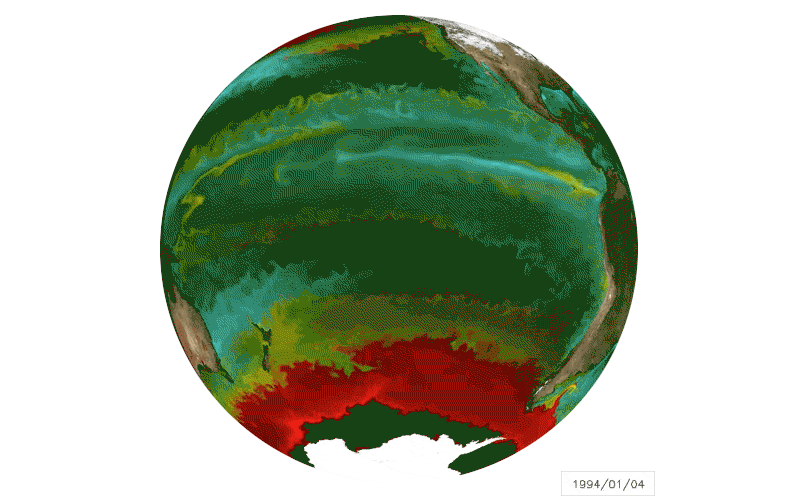
Dominant types of phytoplankton, or photosynthetic marine microbes, are identified at different ocean locations in this model generated by data from 1994 to 1998. Seventy-eight species of phytoplankton are included, and each color represents the dominant type at each location. They include diatoms (red) and other large phytoplankton (yellow). Also shown are small Prochlorococcus-like species (green) and other small phytoplankton (cyan). Courtesy of Mick Follows, MIT
Microbial communities in the ocean coordinate their daily, or 'diel,' rhythms with the sun. These rhythms range from oscillations in gene expression to precisely timed cell division cycles to predator-prey interactions and even to matter and energy transformation. One of the main hypotheses SCOPE researchers test is whether microbial interactions are governed not just by the fact that they are living together in the same current, but by how each species spends and organizes its time. "The idea is that different microbial species line up at precise times during the day, forming a bucket brigade of interspecies matter and energy transfer in organized, predictable ways each day," explains DeLong. "Identifying these interspecies interactions is one of the keys to understanding biogeochemical processes that govern matter and energy flux in and around station ALOHA."
To best investigate these microbial cycles, the oceanographers followed two drifting buoys aboard the research vessel Kilo Moana, which allowed them to track discrete currents and, every four hours or more, to sample water to detect changes in the microbial community. A ship known as KOK tagged along behind, conducting multiple sampling operations along the way.
In order for microbiologists to create simulation models of the microbiome for further testing of community relationships, they need to first collect
massive amounts of data. To help accomplish that goal, biochemist Angelicque White of Oregon State University is measuring the diurnal cycle of light
absorption and production to estimate community productivity at high temporal resolution. Specifically, her team uses optics as a method for estimating
carbon assimilation at daily resolution, from dawn to dusk. This measurement allows the SCOPE team to measure microbial production of organic matter day to
day, and link those changes to fine-scale changes in physical and
chemical oceanography.
Currently, the gold standard for calculating productivity is to directly measure carbon fixation using radioisotopes (C-14 isotopes). White was testing optical methods to measure productivity; the hope is that these methods can be applied to sea gliders, drifters and profiling floats, allowing researchers to quantify ocean production on an unprecedented scale. She says the results are promising. "This method has potential, particularly if we can profile within the mixed layer. It is a practical method for measuring productivity in real time."
"A focus for this cruise was to peer more deeply than ever into the 'days in the life' of oceanic microbial communities," DeLong says. Or, as White put it during the SCOPE annual meeting, to essentially ask the microbes, "How was your day?"




